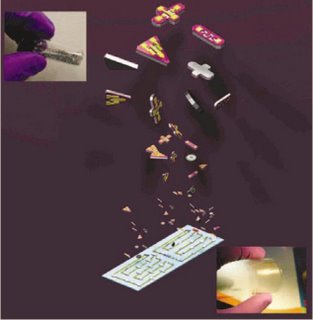16 November 2006
 Fabricating flexible macroelectronic devices, such as large area rollable displays, thin-film solar cells can be labor-intensive. Efforts have been focused on developing fabrication methods that is fast and cheap, such as roll-to-roll printing. Such a process often involves multiple steps of printing, thus the registration precision over large area becomes great a challenge.
Fabricating flexible macroelectronic devices, such as large area rollable displays, thin-film solar cells can be labor-intensive. Efforts have been focused on developing fabrication methods that is fast and cheap, such as roll-to-roll printing. Such a process often involves multiple steps of printing, thus the registration precision over large area becomes great a challenge.Recently, Sean Stauth and Babak A. Parviz at the University of Washington demonstrated a new way to fabricate circuits on a plastic substrate by self-assembly. Thousands of single-crystal silicon transistors and resistors were integrated onto flexible plastic substrates. The micron-scale components self-assembled onto etched channels in the plastic substrates. The assembly process was controlled by using differently shaped components, including
circles, triangles, squares, and rectangles, that selectively assembled in matching substrate channels. After 25 minutes, 97% of the substrate channels were filled with functional circuits. The circuits formed logic inverters and had a high electron mobility,making them potentially suitable for applications.
The research has been published in Proc. Nat. Acad. Sci (2006) 103, 13922
(Image credit: Babak A. Parviz)
0 Comments:
All Topics



